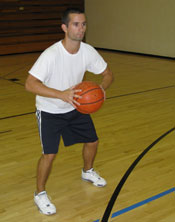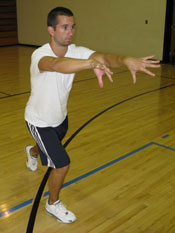Basketball is a team game. By definition, that means all players are involved with the process of playing the game and should function as one. One of the primary skills created to accomplish this is passing. Yet, passing remains one of the most under-taught, under-emphasized, and under drilled skill in the game!!
Players assume the values that the coach places on each aspect of the game. When teaching passing it is important that the coach teach not only the skill, but the mentality as well. Too many players think of passing as something to do when they don't have a shot as opposed to an unselfish act that is designed to include other players.
When teaching younger players, be aware of their physical and mental limitations. Young players usually lack the strength necessary to make the plays that they believe can be successful (like the ones they see on television) and they are still developing their sense of space and time. In addition, their recognition skills can only be honed by experience. Passes that look open to them often are not because they do not have the experience to know how long it takes to get from point A to point B and bad passes are often a result of slow recognition. In either case, negative reinforcement of the attempted pass often results in a reluctance to make the next pass. The long term effect could be a player who does not understand the value of passing and takes no joy in it.
TYPES OF PASSES
There are essentially two types of passes:
- Air Pass - The pass travels between players without hitting the floor.
- Bounce Passes - The pass is thrown to the floor so that it bounces to the intended receiver
Basic Variations:
- Chest Pass
- Bounce Pass
- Overhead Pass
- Wrap Around Pass
Advanced Variations:
- Baseball Pass
- Dribble Pass
- Behind-the-Back Pass
- Pick and Roll Pass
BOUNCE PASS
The bounce pass is thrown with the same motion however it is aimed at the floor. It should be thrown far enough out that the ball bounces waist high to the receiver. Some say try to throw it 3/4 of the way to the receiver, and that may be a good reference point to start, but each player has to experiment how far to throw it so it bounces to the receiver properly. Putting a proper and consistent backspin on the pass will make the distance easier to judge.
OVERHEAD PASS
The overhead pass is often used as an outlet pass. Bring the ball directly above your forehead with both hands on the side of the ball and follow through. Aim for the teammate's chin. Some coaches advise not bring the ball behind your head, because it can get stolen and it takes a split-second longer to throw the pass.
WRAP AROUND PASS
Step around the defense with your non-pivot foot. Pass the ball with one hand (outside hand). It can be used as an air or a bounce pass. You will often see the wrap-around, air pass on the perimeter and the wrap-around, bounce pass to make an entry into the post.
Advanced Passes
BASEBALL PASSA baseball pass is a one-handed pass that uses the same motion as a baseball throw. This is often used to make long passes. Be careful with young kids. You don't want them throw their arms out.
DRIBBLE PASS
The dribble pass is used to quickly pass the ball with one hand off of the dribble. This can be an air or bounce pass. You'll see Steve Nash do this all of the time.
BEHIND-THE-BACK PASS
A behind-the-back pass is when you wrap the ball around your back to throw the ball. It is used to avoid the defender when making a pass across the front of you would be risky. It can also be used to throw the ball to a player trailing on the fast break.
I would not recommend to use this pass during a game until heavily practiced.
PICK AND ROLL PASS


No comments:
Post a Comment